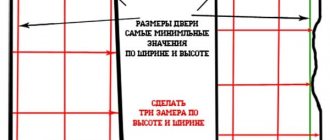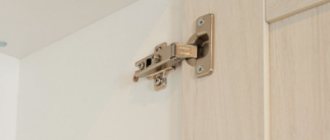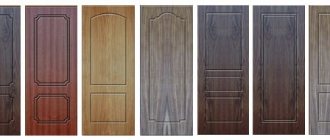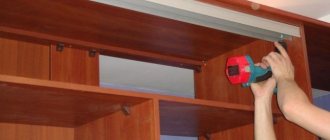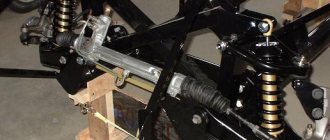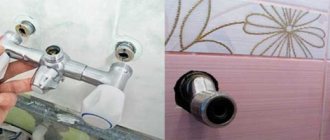Proper installation of extensions on interior doors depends on a number of factors. But as practice has shown, not all amateurs even know what extensions are, so further we will look in detail at the types of extensions and the rules for choosing them, and home craftsmen will learn how to install extensions on an interior door with their own hands, and step-by-step instructions will be given in 4 options .
With large thickness of walls and partitions, extensions on interior doors act as compensators
What is dobor
When installing interior doors, a situation arises when the frame is smaller in width than the thickness of the wall. In such cases, a special board is used, which is attached to the door frame, closing the remaining space. This board is called the addition to the interior door. The names “additional board” and “additional plank” are also found. You can then attach a platband to it, which will close the gap between the extension and the wall.
Extension - a board for expanding the door frame to the thickness of the wall
That is, the door frame is an additional part of the door frame. It is a board of certain sizes, which is joined to the door frame. They place it on one side - opposite to the one into which the door opens. You can also call this board an expander - it reflects its real purpose.
If the wall thickness is more than 140 mm, you have to install a door frame extender - an additional board
There may be some nuances regarding the connection between the fittings. Often the shape of the door frame is specific - with a special relief (protrusions, depressions, roundings). Then you will have to look for a selection specifically from this company, otherwise connecting them will be problematic.
Slopes with slope
When the doorway widens upward or downward, the extensions are installed with the door already in place. This will prevent the door frame from moving away from its normal position. In this case, it is necessary to bring the inner edge of the extension into a wedge, and the extensions themselves in this case acquire a slightly trapezoidal shape. If this is not done, in the wide gap of the place where the doorway widens, after the mounting foam there remains a space where the plaster adheres to this foam. This means that cracks will inevitably form there, and a piece of the wall may become loose, crumble and begin to fall out in pieces.
Materials and sizes
Each manufacturer produces a certain set of additional boards, in which the length is fixed - 230-250 cm, the thickness/width varies. For example, there are the following options (thickness, width, length):
- 10*50*2350 mm;
- 10*100*2350 mm;
- 15*150*2350 mm.
Shape, thickness, width may vary
Thickness and width - each factory has its own. Can be 60 mm, 65 mm or 75 mm. In general, any set. What if none of them suits your case? Take a larger width than required, then saw off the excess. What if your opening is wider than all available options? Order the size you need (many manufacturers make to order) or splice two smaller sizes. Another option is to use telescopic platbands. They come with a corner bend, which can cover your width gap.
If the doors are made of solid oak, it makes sense to install the same addition
What materials are interior door trims made from? From the same as platbands:
- wood;
- MDF;
- Chipboard.
MDF and chipboard can be covered with veneer and laminated. Wooden ones can be treated or untreated. Select the material and color for the door frame. And this is another reason to buy from the same manufacturer - even if the color/texture name is the same, there is no guarantee that they will actually be the same.
Calculation of the number of elements
There are standards to which door manufacturers make doors. In Europe, the standard door height is 210 centimeters, in Russia it is two meters. The extensions, accordingly, must be of identical length. And they can have different widths: from 5 to 55 centimeters. High-quality wooden elements or MDF elements have a width of 10 millimeters.
It is difficult to select parts for private houses. They were built without taking into account modern standards. This often makes it difficult to choose extensions of the required length and width.
Next the question arises, how to calculate the number of elements. When making calculations, you need to take into account and know that:
- During installation, the extension will go a little deeper, and accordingly, its size will decrease;
- The distance between the edges of the door frame is measured with a tape measure;
- All measurements are checked in three places: on the left, top and right of the opening;
- The working value will be the largest.
Here is an example of the calculation. The partition has a width of 240 millimeters, the door frame is 80 millimeters. This means that an additional 160 millimeters is required. A blade 200 millimeters wide will suit you; excess is removed with a saw or jigsaw.
Types of additions
There are two types of additional board:
- With straight edges. An ordinary board that is attached end-to-end to the box. It can be: with a decorative edge;
- without decorative edge.
Types of extensions for interior doors: telescopic on the left, regular on the right
The addition to an interior door with straight edges is the most common board. In this case, it needs to be selected only by color and size. The extension is pressed against the box and secured with screws installed diagonally. One of the ends of the additional strip can be processed. This is necessary if the casing can be displaced.
Installation of an extension with smooth edges (not telescopic)
It is not very convenient to attach this type of extension. You have to think about how not to split the plank and how to close the screw heads. However, you don’t have to select the shape of the grooves/protrusions, which is far from simple and ties you to only one manufacturer.
If there are protrusions, grooves, roundings, you need an extension for the interior door from the same company as the frame
The telescopic door panel has pre-formed grooves. From the point of view of joining, this is a very convenient option: drive the protrusion into the groove, tap it until it matches completely, and the whole installation is complete. But only if the match is perfect. How else is telescopic extension convenient? You can install a telescopic casing in it (if it fits).
Features of installation of telescopic bars
Installing panels with grooves is quick and easy. The wall and side of the box are pre-cleaned. The extensions are tried on, the excess is cut off. The top (horizontal) element is installed, then the sidewalls. The planks are inserted into the grooves of the box to the required depth: the panel should cover the open sector of the wall. The end of the bead is tapped with a mallet. The panel is attached to the wall using liquid nails. The horizontality and verticality of its surfaces is checked by a level. At the end, the platbands are put on. If the opening has a depth exceeding 15 cm, the telescopic bar is assembled from two or three parts. The stackable telescopic panel will firmly fix the frame, ensuring the reliability of the door structure.
How to install extensions on an interior door
In this paragraph we will talk about ordinary planks - with straight ends. Sold in lengths of 2100-2300 mm. Three strips are needed for one door: One on the right and left, and a piece from the third will go to the upper part. If you install several doors at the same time and they are the same color, one strip will go to the two “tops”.
How to attach fittings to an interior door
The width and length of the planks are usually larger than necessary, so they will have to be trimmed. What instrument? With what you have. A jujube that cuts DMF, chipboard or wood is suitable. To decorate the corners, you may need a miter box (if you are going to join the box (and extensions) at 45°. It is also convenient to use in order not to “fill up” the cut and make it strictly perpendicular.
We take measurements and make blanks
Before installing the extensions on the interior door, you need to find out the exact dimensions of the expansion strips. To do this, install a door frame in the doorway and secure it. Draw an opening on the plan; it will be easier to write the dimensions. Next, take a tape measure and a level, measure the size of the extensions that you need.
- The width of the extension is determined as follows: insert the measuring tape of the tape measure into the groove until it stops. We apply a level to the wall and determine the required width at the intersection with the tape measure. We take measurements at six points: two on each side. If the wall has unequal thickness, we take the width of the extension according to the largest number.
We measure accurately - Length of additional strip. Again, take a tape measure and measure along the opening - from the floor (threshold, if anyone has one) to the beginning of the groove in the frame of the installed door. We measure on the right and left, because again there may be a difference. We measure the upper part from the beginning of the box to its end (not from the groove).
Now we cut out the sizes we need from standard planks. Make marks with a pencil - on light strips a simple pencil is clearly visible, on dark ones you can use a white one. We try on the cut strips in the opening; if necessary, we trim them a little.
We collect
Before placing the extensions on the interior door, they must be connected to each other. We lay out the cut out additional strips on the floor in the form of the letter “P”. If they have a processed edge, lay them out so that the edge is on one side. The planks will need to be connected to each other. If they are made from MDF or chipboard, you will need to pre-drill holes in the top rail.
Preparing for assembly
To do this, it is better to take a square (ideally a carpenter’s square, but an ordinary school one will do). We draw a line on the plank that marks the middle of the thickness of the plank. If the thickness of the additional board is 10 mm, the line runs at a distance of 5 mm from the edge. If the plank is 15 mm thick - at a distance of 7.5 mm. We put two points on this line and then drill holes. Diameter - 1 mm less than the diameter of the screws.
We complete the assembly of the door frame
Next, the holes must be transferred to long strips. To do this, we join them and align the edges. Using a drill, we transfer the marks to the end of the plank, then deepen it to the required length (along the length of the self-tapping screw). Having made the holes, we join the planks and tighten the fasteners. The extension to the interior door is half assembled. But don't rush to attach the second bar. You need to try on what has already been assembled “in place.”
Fitting and trimming
We put the assembled L-shaped part in place, driving the strips into the groove in the door frame. The upper jumper turned out to be larger (this is how we measured it). Take a pencil and put a mark where the groove begins. Try to be precise as this is important. You don't have to cut off the excess. We simply draw a line along the mark and make marks on it, then drill holes. After assembly, the letter “P” is obtained. We have assembled the extension for the interior door, now we need to install and secure it.
Installation in a door frame
Now the addition can be installed. Check the opening first. If the doors were placed on foam, it may block the groove. We cut off the excess so that the planks fit freely. Insert the U-shaped structure into the groove, tapping the end with your palm. We start from the top, then to the sides.
We put it in place, having first removed the excess polyurethane foam.
We take masking tape and use it to fix the planks to the walls. If in some places the extension on the interior door does not fit tightly to the frame (there is a gap), we remove this gap with the help of pads. You can use mounting wedges for this. If you don't have them, make them from foam plastic. You just need to set the bar level; dense foam plastic is enough for this purpose.
Fastening the additional box
You also need to level the extension to the interior door. You shouldn’t rely on your eye; use a level. Using a level and wedges, we remove all protrusions and blockages. During the process, we fix the aligned areas with masking tape. The distance between the tacks is 40-50 cm. One at the top and bottom (stepping back about 10 cm), and then at equal intervals.
How to attach the extensions: during the installation process
Next, using polyurethane foam with low expansion , we fill the space between the wall and the additional strip with it. Before use, read the instructions on the cylinder. It may be better to moisten the surfaces. In any case, the polyurethane foam must be laid in stages, otherwise it may bend the extension strips. Everything will have to be torn off, cleaned and foamed again.
So, first we apply foam deep into the gap. Not much, one strip. At the same time, we make strips across the entire width near the “tacks” (an example of applying foam to the door trim is in the photo above on the right). The foam in the area of the tacks will give the bar stability, the strip in the far part - near the joint - will press the extension to the groove, but will not bend the bar.
We leave the foam on the side strips to polymerize while we fill the gap from above. If it is as big as in the photo, there is no point in transferring a lot of foam. It’s easier to cut out a “bookmark” from foam plastic and place a wooden block of a suitable size. It is slightly smaller in size than the free space. There should be a gap of at least 1 cm on all sides. But too large gaps are not needed.
How to install extensions on an interior door: filling the top gap
Next we proceed like this:
- We place small pieces of polystyrene foam 1 cm or so thick under the embedded part.
- Using a snake, apply a layer of foam to the back wall (if there is one).
- We install a foundation block and fill the gaps around the perimeter with foam. Again, not too much so that the foam extension bar does not bend downwards.
- If necessary, install a “front” bar (bottom left in the photo above). If the width of the block is sufficient, we skip this step.
- We level the position of the additional strip using a building level and secure it with masking tape.
After the first layer of foam has hardened (the time is indicated on the can), we fill the remaining space. If the extension to the interior door has a significant width, it is possible (and better) to apply foam in two stages. But each time you need to wait for the polymerization time. After that, all that remains is to install the platbands.
Immediately with the box
Sometimes the extension is installed on a box that has not yet been inserted into the opening. This method of installation has its advantages, since everything being mounted lies on a horizontal surface (preferably on a workbench or large table, but 4 stools of the same height in the corners of the assembled structure will do).
- The parts of the box, laid out in order, are stacked with the inner side facing the door facing up.
- Angles are leveled up to 90⁰. This can be done with a cord or thread, pulling them diagonally until they are equal to the millimeter. Then I fix this position of the box with a temporarily nailed bar.
- Along the perimeter, this entire structure is sheathed with plywood or plasterboard, with their protrusion upward outside the box, so that later the protruding parts of the extensions can be fixed along them. The result will be a structure that fits exactly into the future opening. The extensions are cut to size, and the top strip is glued first, the length of which will touch the limiters installed on the sides. The second to be planted on the glue are the side extensions.
- After the glue has dried, the retaining strips are removed.
- The entire assembled structure is placed in the doorway, fixed and leveled using a level, plumb line and wedges, and then secured with anchor bolts or long self-tapping screws.
How to attach the extension to the door frame if it is thicker than the selected quarter
Often the extra is thicker than the quarter selected in the box. What to do then? How to make sure that the extension rests without cracks and holds tightly? There is a simple way - drill holes diagonally, screw in self-tapping screws, then close the holes with matching plugs. Here everything is more or less clear, but not very beautiful - the stubs are still visible.
There is another way. Need drywall hangers. Only they should be the strongest and thickest. We separate the perforated parts of the tape from the hangers. Each one makes two pieces. You will also need small screws (fleas). We screw the perforated tapes onto the door frame around the perimeter - at the corners at a distance of 10-15 cm, also at the bottom, and in height at a distance of 40-50 cm.
How to secure the addition
We screw in the screws at a distance of 1.5-2 cm from the edge of the box (middle photo). One self-tapping screw per piece of metal tape is enough. When you install the door frame, the tape will stick out. These strips are thin, so there will be no problems with even the smallest gap. If the extension to the interior door is the same width, simply insert it. Due to their elasticity, the plates press it tightly.
How to install extensions if they are thicker than a quarter
If the extension is wider, first we bend them to the front part, then return them back. Due to the fact that they are not fixed at the edge, they bend and become like an arc.
This is how it can work out - without the slightest gap
Now we insert additional strips, placing them between the plates and the groove. They will press the bar tightly. The cracks will not be visible even upon closer inspection.
Calculation of the number of elements
There are standards to which door manufacturers make doors. In Europe, the standard door height is 210 centimeters, in Russia it is two meters. The extensions, accordingly, must be of identical length. And they can have different widths: from 5 to 55 centimeters. High-quality wooden elements or MDF elements have a width of 10 millimeters.
It is difficult to select parts for private houses. They were built without taking into account modern standards. This often makes it difficult to choose extensions of the required length and width.
Next the question arises, how to calculate the number of elements. When making calculations, you need to take into account and know that:
- During installation, the extension will go a little deeper, and accordingly, its size will decrease;
- The distance between the edges of the door frame is measured with a tape measure;
- All measurements are checked in three places: on the left, top and right of the opening;
- The working value will be the largest.
Here is an example of the calculation. The partition has a width of 240 millimeters, the door frame is 80 millimeters. This means that an additional 160 millimeters is required. A blade 200 millimeters wide will suit you; excess is removed with a saw or jigsaw.
Key Requirements
In order for the dimensions of the box to match the canvas in accordance with established standards, it is necessary to highlight the basic directions of the size ratio, in accordance with the standard requirements of GOST:
- The gap between the wall and the box should be 1-1.5 cm, so that there is space for adjusting the position, shock absorption and uniform load distribution through the use of polyurethane foam.
- There is a gap of 3 mm around the entire perimeter between the canvas and the loot. The distance from the floor to the door in the absence of a threshold should be 1 cm.
- For heat and sound insulation, it is envisaged to use a sealing strip around the entire perimeter. If the required gaps are not maintained between the canvas and the box, use a thicker seal.
Recommended sizes
If the elements filling the doorway violate the standard dimensions, they can be corrected - by filing the frame or removing a layer of canvas.
Of course, it is not advisable to do this, but if there is no other choice, try not to damage the front covering. To increase the size, inserts and fillers are used.
To avoid getting into a difficult situation, order doors after completing the main work on remodeling and finishing the opening. Pay special attention to the choice of company, its reputation and the level of qualifications of its employees.
